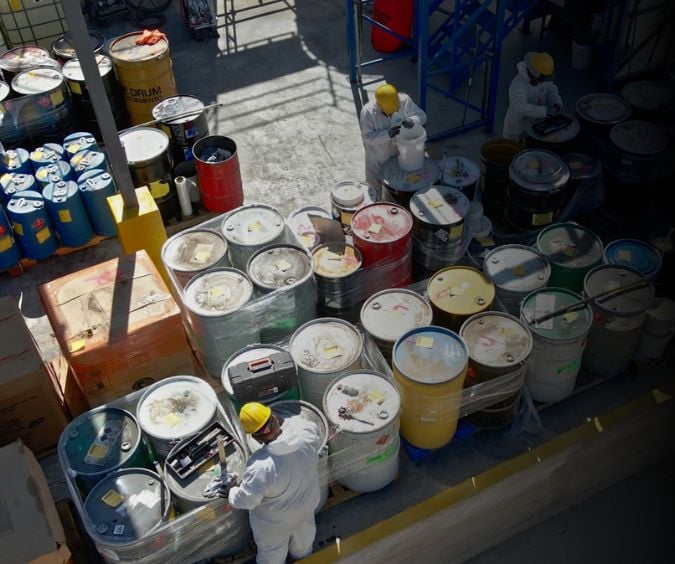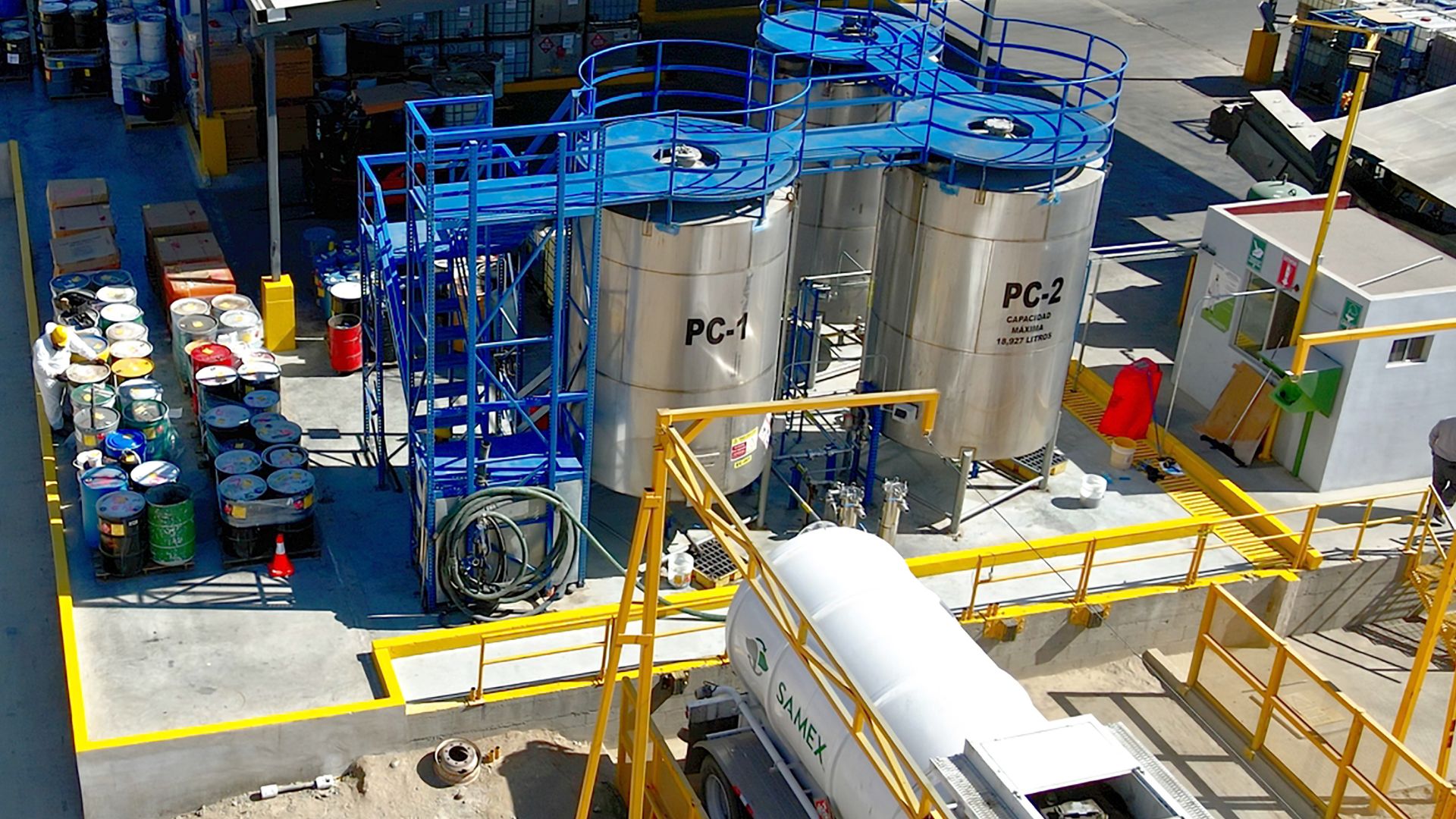Does Your Factory Meet These Storage of Flammable Liquids Regulations?
When handling flammable liquids in a factory setting, proper storage is not just a matter of convenience. It’s a critical safety measure that helps...
4 min read
 Larry Burton
:
Oct 21, 2024 11:40:01 AM
Larry Burton
:
Oct 21, 2024 11:40:01 AM
.png)
Storing flammable liquids in warehouses poses significant risks, but adhering to best practices can significantly enhance safety and compliance.
Proper storage not only prevents accidents but also ensures that your facility meets regulatory requirements. Effective management strategies can help mitigate fire hazards and improve overall safety.
Here are five tips to help you boost safety in your facility that focus on storage of flammable liquids in warehouses:
Proper labeling and signage are critical for maintaining safety when storing flammable and combustible.png?width=300&height=251&name=Hazardous%20Waste%20Disposal-Bebas%20Neue%20(2).png) liquids. Every container should be clearly marked with the correct hazard symbols and warnings, ensuring that workers can immediately recognize the contents and understand the associated risks.
liquids. Every container should be clearly marked with the correct hazard symbols and warnings, ensuring that workers can immediately recognize the contents and understand the associated risks.
Consistent labeling also aids in compliance with OSHA and NFPA regulations, reducing the risk of fines or legal issues during inspections.
In addition to labeling individual containers, place visible signage throughout the storage area. Signs should identify fire risks, indicate where flammable liquids are stored and outline emergency procedures in case of spills or fires. This not only provides workers with constant reminders of the hazards but also guides them in how to respond swiftly in emergencies.
Proper signage can save critical seconds in a fire or spill situation, reducing potential harm to employees and property.
Key Things to Know About Labeling and Signage:
Labeling and signage are simple but powerful ways to boost safety in flammable liquid storage, ensuring that workers are always aware of the risks and how to handle them.
Flammable liquids release vapors that, when confined in enclosed spaces, can create fire and explosion hazards. Proper ventilation is key to preventing vapor build-up and ensuring a safer working environment.
Whether through natural airflow or mechanical ventilation systems, keep air circulating in storage areas where flammable liquids are present. This helps disperse hazardous vapors, reducing the risk of accidental ignition.
Regular maintenance of ventilation systems helps to ensure they function properly. In areas with high vapor concentrations, consider using explosion-proof equipment to further reduce risks.
Key Things to Know About Ventilation:
Proper ventilation is a proactive measure to keep both employees and your warehouse environment safe from the risks associated with flammable vapor build-up.
Spills involving flammable liquids are a serious hazard, so having effective spill containment systems is essential for maintaining warehouse safety. Utilize spill kits, secondary containment (such as berms or trays), and flame-resistant barriers to control leaks and prevent the spread of flammable materials. These measures help to contain spills quickly, reducing the risk of fires igniting and causing widespread damage.
maintaining warehouse safety. Utilize spill kits, secondary containment (such as berms or trays), and flame-resistant barriers to control leaks and prevent the spread of flammable materials. These measures help to contain spills quickly, reducing the risk of fires igniting and causing widespread damage.
Employee training is also critical. Workers should be regularly trained on spill response protocols, ensuring they know how to handle emergencies, use containment tools effectively, and follow proper safety procedures. This preparation can help minimize the impact of spills and protect both people and property.
Key Things to Know About Spill Containment:
Having robust spill containment measures in place not only boosts safety but also ensures compliance with environmental and safety regulations.
Compliance with OSHA and NFPA regulations is essential for safely storing flammable liquids in warehouses. These guidelines provide clear rules on how to store flammable materials, including requirements for proper spacing, the use of approved storage cabinets and limits on the quantity of liquids that can be stored in specific areas.
By adhering to these standards, businesses not only reduce fire risks but also avoid potential fines and legal issues during safety inspections.
Properly implemented, OSHA and NFPA guidelines ensure that storage is safe, organized and less prone to accidents. Regular audits and updates to your storage procedures help keep your warehouse compliant and maintain a secure environment for employees.
Key Things to Know About Storage Guidelines:
Following these regulations helps create a safe storage environment and demonstrates a commitment to workplace safety and compliance.
Storing flammable waste for extended periods significantly increases the risk of fire hazards in your warehouse. Accumulated waste can become volatile and unpredictable, making it essential to dispose of it as soon as possible.
Delays in waste disposal not only create unnecessary safety risks but can also result in non-compliance with environmental and safety regulations.
To reduce these risks, work with certified disposal services or Treatment, Storage, and Disposal Facilities (TSDFs) that accept hazardous waste. These facilities are equipped to handle flammable materials safely and ensure proper disposal according to regulatory standards.
One of the popular methods for disposing of flammable liquids today in industry is solvent distillation. This process offers businesses a safe method for disposing of their flammable waste while boosting a company’s sustainability.
What is solvent distillation? Solvent distillation is a process that recovers and purifies used solvents, allowing them to be reused. This process ultimately reduces waste and environmental impact. Samex Environmental accepts a wide range of halogenated and non-halogenated solvents for solvent distillation, including acetone, methanol, toluene, xylene and dichloromethane.
There are other disposal methods for flammable liquids as well, including incineration. However, solvent distillation allows companies to improve their sustainability initiatives by ensuring nothing is wasted. At Samex:
You can read more about the solvent distillation process in our article, How To Dispose Of Flammable Liquids Sustainably.
Key Things to Know About Flammable Waste Disposal:
Efficient waste management is crucial for both safety and compliance, ensuring your warehouse minimizes unnecessary risks. By exploring options like solvent distillation, companies can reduce their environmental impact and ensure that materials are repurposed rather than wasted.
.png)
When handling flammable liquids in a factory setting, proper storage is not just a matter of convenience. It’s a critical safety measure that helps...

The proper storage of flammable liquids stands as a critical line of defense against potential disasters.

Discover the essential regulations and guidelines for the safe disposal of flammable liquid waste. Understand the importance of proper handling and...